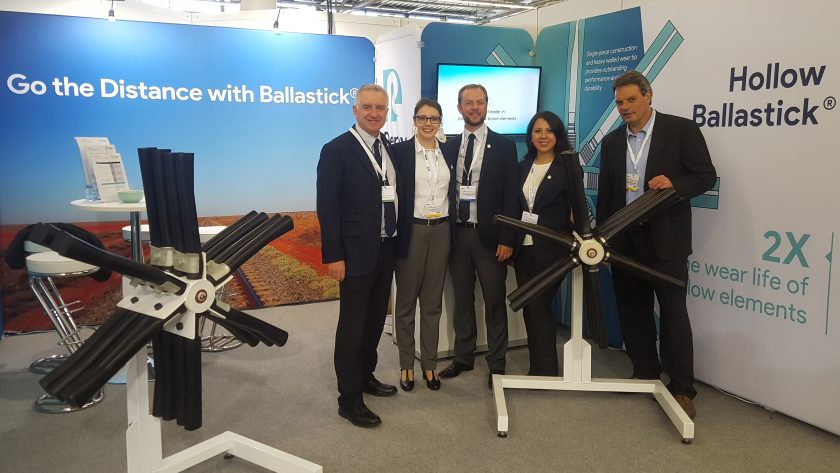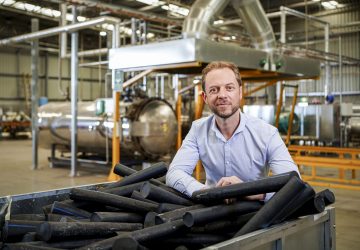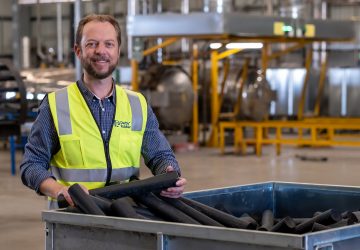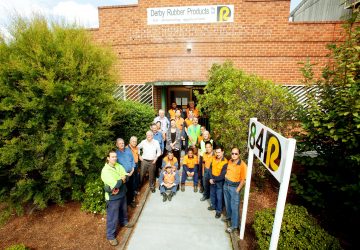
Derby Rubber celebrates 20 years in Europe
In the early 2000s, Derby Rubber took the bold step of establishing a permanent overseas presence in one of its key market centres. Two decades later, Derby Rubber’s Dutch office has built and nurtured strong relationships with Europe’s leading rail companies, supplying its pioneering Ballastick® broom elements to infrastructure operators across the continent.
We asked Derby Rubber Director, Stephen Sheppard to reflect on the origins and successes of Derby’s two decades in Europe.
Why did Derby Rubber look to set up operations and warehousing in Europe?
Derby Rubber’s focus on Europe started across the Atlantic, in North America. The popularity of our products there suggested that we’d probably gain the most interest in countries that appreciated the durability, value and operating efficiency of our broom elements. This insight, combined with its intensive rail network, led me to choose Europe as the next export market beyond North America.
At the time, our exports were being handled by overseas distributors and re-sellers, which clouded our visibility of the market – we really didn’t know who was using our products.
By establishing a wholly Derby-owned distributor in Europe, we could start to establish and develop deep, long-lasting relationships with the folks who use our broom elements. Importantly, we could also offer delivery times of less than a week rather than the 7-8 weeks of other imported products.
Why did you choose The Netherlands as the base for Derby Rubber in Europe?
We looked at a few countries across Europe, but ultimately it was The Netherlands that stood out. Back then, as it does today, the country offered a very business-friendly environment and catered well for international companies looking to establish their European distribution centres there. The government administration is super-efficient, and the locals are wonderfully friendly. So, when coupled with its great sea, air, rail and road infrastructure, The Netherlands was an easy choice to be Derby Rubber’s home in Europe.
What makes The Netherlands such a strategic hub for Derby in Europe today?
There are two reasons for this, one is bureaucratic, and one is geographical. The Netherlands is a core member of the EU, and most of our key European customers are also part of that vast economic alliance, which makes trade across markets a lot easier.
Secondly, the warehouse is located in the village of Klarenbeek, quite close to Germany where our larger customers are located, but also not far from major importing hubs. Just about all our products are shipped through the Port of Rotterdam, which is around 90 minutes away, but if even greater urgency is required, Schiphol airport is also close by.
Where are the key areas of growth you’re focusing on in Europe?
Rather than just being geographical, further expansion will come from product innovation to continue to improve sustainability whilst maintaining or increasing the longevity of our products beyond 160 kilometres of track life.
Have operations and supply-chain systems changed since the pandemic?
Having a well-stocked warehouse in The Netherlands certainly allowed us to maintain supply reliability to customers during the outbreak of the pandemic. We couldn’t have done it without our Dutch hub. This was further highlighted by the Ever Given obstruction of the Suez Canal in March 2021.
Through it all, the reserve of product in Europe helped give our customers peace of mind. The pandemic underlined the absolute importance of being able to respond to customers’ needs, even when global supply chains are disrupted.
How does the European market differ from the domestic Australian market?
The European market is larger than the Australian market but, perhaps due to lingual, cultural diversity, is more fragmented as well. Very few customers operate on a pan-European scale. Instead, there are quite a lot of small track-sweeping operators that only focus on their own or perhaps a neighbouring country. And each has a slightly different way of running their business, so we spend a lot of time building unique relationships to genuinely understand every customer’s needs.
What are some of your key highlights from the past 20 years in Europe?
- Receiving the very first order for broom elements in 2002 from the Dutch company Volker Stevin. I had just cycled from a meeting with the customer’s purchasing manager and was grabbing a late lunch at a table outside a pub. While enjoying the autumnal sunshine, my Blackberry buzzed (remember them?) It was an email from the fellow I had just met with, complete with an order attached! I ordered another beer and lingered a bit longer to savour the moment. I established Derby Rubber Products (Europe) B.V. in April 2002, and this order came through a few months later. It was confirmation that the bold decision was indeed the right one, and I could breathe at last.
- Receiving the first order from the Dutch company Strukton Rail Equipment B.V. in the very charming Dutch city of Zutphen. We had, for some years, been selling Solid Ballastick elements to the USA, but I didn’t know that our U.S. distributor was selling these on to Strukton’s subsidiary in Sweden. The purchasing manager in Zutphen presented me with my own product and asked me to provide a quote! At the time, I didn’t even realise the product was being used in Europe. Ultimately, the Solid Ballastick uptake led to the development of the hollow version so it could be fitted to existing brush axles in Europe.
How has the Netherlands office helped build Derby’s success and growth over the past 20 years?
On the back of being in Europe and seeing the need for specific product innovation, the development of the Hollow Ballastick in 2004 drove the growth of the business. To really seize upon market opportunities and expand, you have to be there to learn and observe. For good reason, railway customers are conservative, and we can’t expect them to leave long-term suppliers for a sales representative travelling through, living out of a suitcase. A long-term, patient commitment was, and still is, the key to building the market. Success could come from a range of factors, but from my experience, it all boils down to two things: having a targeted, innovative product, and having enjoyable, trusted relationships with customers. Both of these take time to develop. We’ve been doing this now for over two decades, and we look forward to whatever the next 20 years in Europe will bring.





